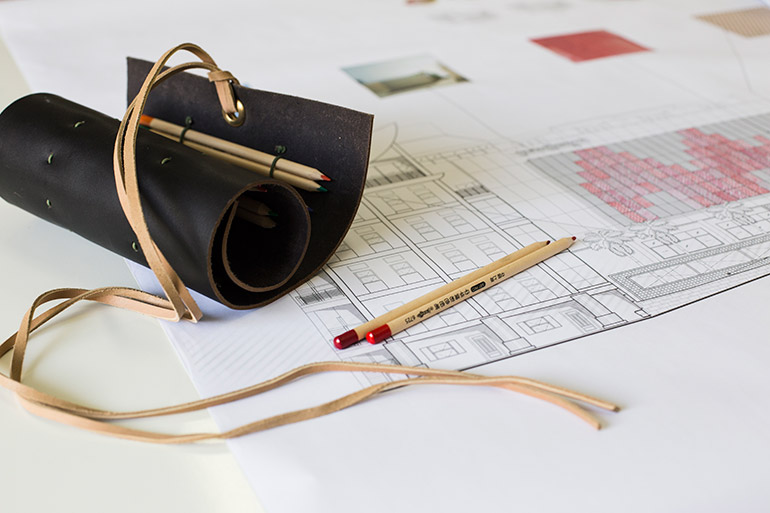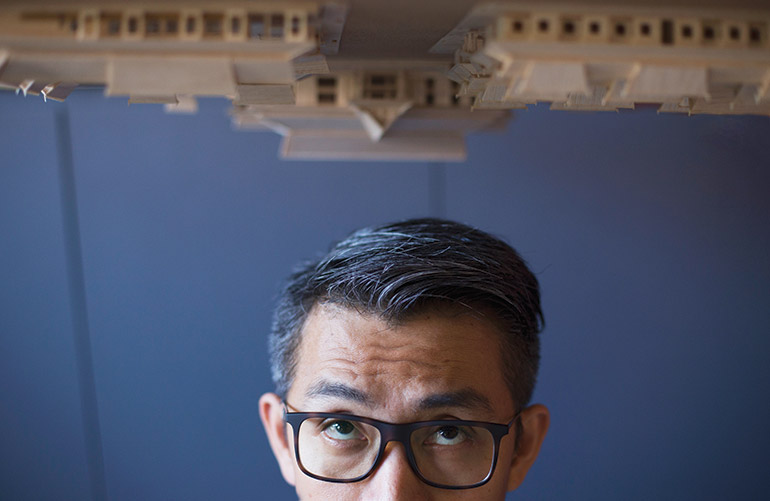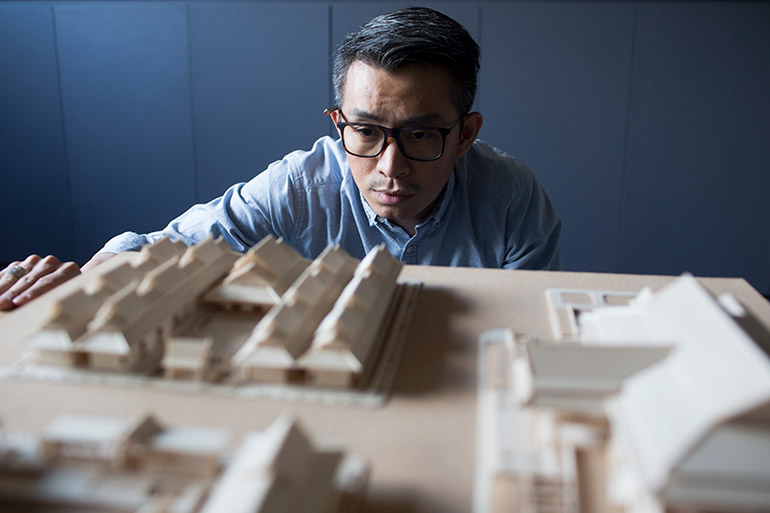The interiors of 37-year-old architect Hun Chansan’s Phnom Penh practice – a renovated 1960s villa in the swish suburb of BKK 1 – could be straight out of the pages of a tropics themed issue of Wallpaper* magazine. Beyond a small, minimalist lobby sits a large co working table with vases of lotus flowers and about 20 young architects clicking away at their computers. Huge plaques are studded to the walls showcasing the team’s recent work, from a 16-storey boutique hotel in the centre of the city to an ambitious plan for all of Phnom Penh – a city in the throes of rampant and unchecked development – consisting of residential areas and public parks, business districts and cultural hubs.
“Here, my team has the option to design – to be inspired – rather than just looking at rebar and steel and concrete or checking technical drawings,” he tells me as we walk past one of his staff sketching away on a notepad.
Chansan is referring to a crossroads that his six-year-old business, Re-Edge Architecture, was faced with two years ago. He and the startup’s other two founders, who now run a successful construction company, decided to part ways after disagreeing on the company’s creative vision. “They wanted to focus on building rather than the creative side. I wanted no conflict of interest between the design and the build, and construction tends to favour things such as profitability, simplicity, speed and cutting corners over smart, sustainable design,” he said. These days, with a staff of 25 working on eight projects, Chansan is confident he made the right choice.
Re-Edge’s designs, Chansan says, value storytelling, geography and risk taking. In 2013, the team first sketched out blueprints for Lumiere, the sleek, 16-storey hotel, which opened last month in Phnom Penh. Its design pays homage to Cambodia’s 1960s architecture hero Vann Molyvann’s lotus-shaped Independence Monument, which can be seen from various angles of the rotating geometric floors. “I don’t believe in just building a box and living in it,” Chansan says.
When it comes to process, Chansan says he values detail and thoughtfulness over speed. “There should be a vision for the city as it grows, a master plan to solve issues of population growth, traffic…infrastructure, zoning, parks, social housing, cultural buildings,” he says. “In a developing country, everything goes up so fast. Everyone has the mentality that building is better than not building, but then they forget about the outcome – what happens afterwards?”

Over the past 15 years, Phnom Penh has witnessed rapid economic growth and swift structural development. The city’s skyline is awash with soaring, half-built condominiums, cranes and towers. Last year was a record one for construction, with a total of $8.5 billion worth of projects approved.
Re-Edge has won a significant number of bids over the past few years, something Chansan puts down to four key factors: the talent of the team; his own commitment; the firm’s design “personality”; and the fact that he is “well connected” – a phrase often shied away from by successful Cambodians but one that he is quick to acknowledge as a factor. “I absolutely feel very lucky to have the opportunities I’ve had. Without them, I may not be here now,” he says.
Chansan grew up in an era when civil war still plagued the nation. His father and uncles tapped into a burgeoning market for photography – most Cambodians’ family photos were destroyed during the Khmer Rouge years – and set up a string of photo studios around the capital’s Central Market, where they lived.
They also acquired valuable land. A patch of lucrative real estate where the famed Sam Doo Chinese restaurant now stands is the former family home (they now lease it out). In 1991, as foreign UN peacekeeprs and NGO workers streamed into the country, his father established one of the city’s first hotels: Mittapheap Hotel on Monivong Boulevard, which Chansan gave a slick facelift in 2012 and rebranded as Mito Hotel.
As political tensions heightened in the mid-1990s, Chansan’s parents sent him to Singapore to finish high school. And it was there, with the city-state’s intriguing blend of heritage structures and modern buildings, that his early fascination with architecture was born: “I was always quite good with art and sketching, and a Singaporean teacher mused that I had the patience and creativity needed to be an architect.” He went on to study two degrees in fine arts and architecture and a master’s in urban design in the US, at Boston’s Northeastern University.
It was there that he “gained a deep sense of what architecture is”, after being exposed to the urban planners of ancient Rome and Greece and risk-taking architects such as Le Corbusier. “I also developed a real interest in the work of Vann Molyvann and the New Khmer Architecture movement of the ’50s and ’60s,” he says. “Every time I’d come back to Phnom Penh for a visit I’d drive past the Institute of Foreign Languages and think: ‘Wow, look at these shapes.’ It was like: ‘What’s going on here?’”

Chansan is dismayed that many of Molyvann’s buildings have been destroyed to make way for colossal condominium developments. “The Olympic Stadium, for example, is so important for the memory of the city and because it is a public space. Buildings are about how people live in them. I have memories as a kid swimming in the pool and playing tennis there; now I take my son to do the same. I think a good city should look into how people need to use it.”
One project developing along such lines is the proposed $40m Sleuk Rith Institute in Phnom Penh, a genocide museum and research institute. Designed by recently deceased, Iraq-born ‘starchitect’ Zaha Hadid, it is a twisting, tapering structure of five interconnected towers. “Man, I really hope this gets off the ground,” Chansan says. “A great building can transform a city.”
Such grand designs would, most likely, require careful cultivation of Chansan’s connections, particularly by those he refers to as “my generation” of the Khmer diaspora returning to help develop Cambodia’s business landscape. “We all have a similar mentality of wanting to make changes here. We see the problems of the country and want to change it. It’s not just about holding hands; we want to improve things.” Nevertheless, connections he isn’t overly keen on nurturing, he says, are government ones. “Because I’ve been away so long, I don’t really follow their protocol. I don’t want to play that game.”
“I want to make architecture and building good again here,” he adds. “We want to be part of the new face of Phnom Penh. We can’t rely on the [Angkor] temples; we need to evolve and bring something new.”
To this end, Chansan has lectured in architecture at a number of Cambodian universities, but he sees fundamental flaws in the education system. Currently, there are about 2,500 Cambodian architecture graduates in the country, but only 500 of them are practising the profession.
“There’s also no rule or regulation that promotes Cambodian architects over foreigners coming in,” he says. “For example, in Thailand, any foreign architect cannot design alone, they must partner with a local firm. At the moment, it seems anyone can do anything, anywhere, any time in Cambodia. That really needs to change.”


